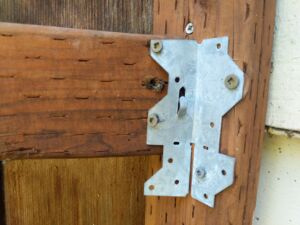
Fastener holes are designed to be filled completely with the designated number of fasteners to appropriately secure the hardware components to the fencing or gate structure. Leaving these holes empty can compromise the structural integrity of the fence or gate, making them susceptible to loosening, wobbling, or even collapsing under stress. Filling the holes ensures that the fasteners are tightly secured, providing stability and strength to the entire structure. Correction of weak and loose fencing and gate components is imperative in preventing failure of these systems and potential personal injury. A weak or failing fence and gate system may also allow for easier access to the protected spaces of your yard by unwanted intruders. Additionally, hardware that lacks appropriate fasteners and that are showing signs of failure can be an aesthetic and cosmetic defect.

To repair hardware with missing fasteners, we recommend identifying the manufacturer of the given hardware member to seek the manufacturer’s recommendation for appropriate hardware types. If this information cannot be obtained, we recommend utilizing the previously recommended galvanized steel or stainless-steel fasteners. If the wooden members have become displaced from movement at the fencing due to inadequate fastening, new hardware or wooden members may be required to proceed with the repair. In this scenario, we recommend further evaluation and repairs made by a qualified contractor. If all wooden members are in their appropriate designated place, but are simply missing fasteners, then the repair would require simply adding the appropriate number of approved fasteners into the empty fastener holes at all hardware pieces of the given gate and fence system.
Although a fence may appear to be stable and intact with missing fasteners, these weakened connection points can lead to failure over time. To extend the life of your fence and gate systems, we recommend being proactive and filling all designated holes at the fence hardware with appropriate fasteners. Fences and gates experience wind forces and vibrations from use at adjacent gate systems, these forces overtime can loosen and weaken connections made at fasteners and hardware. Ensuring that an optimal amount of strength is present at the fence hardware will help mitigate the movement created by these forces and better protect the fence and gate system for long term use.
